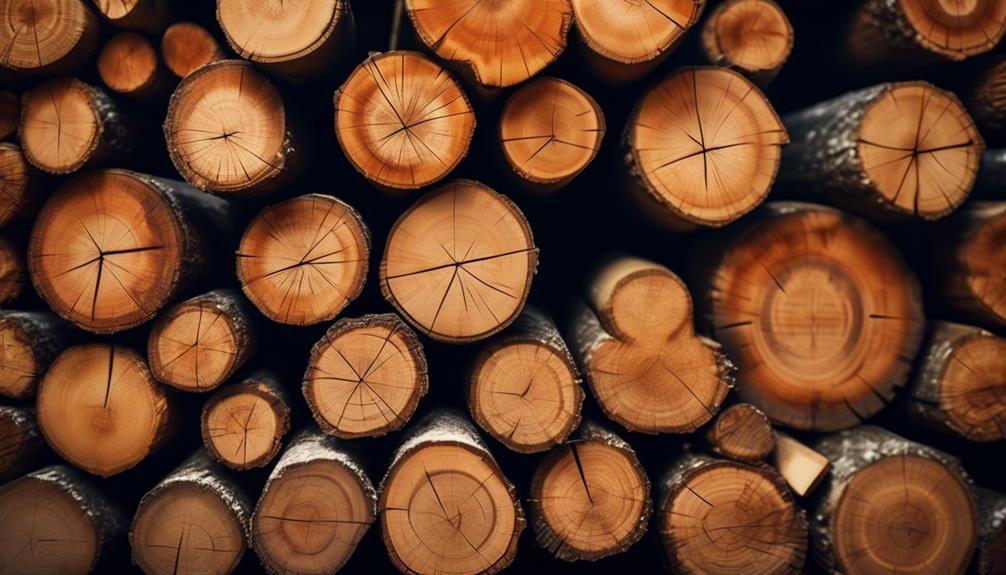Have you ever shouldered the weight of firewood and wondered about its surprising heaviness? Maybe you've noticed that some cords of firewood feel unexpectedly burdensome, while others seem lighter than you would expect.
In this discussion, we will uncover the factors that contribute to the weight of firewood, shedding light on some unexpected insights. From the impact of moisture content to the type of wood and its density, we will explore the various aspects that influence the weight of firewood.
So, prepare yourself for a revealing exploration into the weight of firewood, where you'll discover fascinating information that might just change the way you perceive those seemingly innocent logs.
Key Takeaways
- The weight of a cord of firewood can vary greatly depending on factors such as moisture content, wood type, and density.
- A cord of firewood can weigh anywhere from 2,000 to 5,000 pounds and takes up about 128 cubic feet of space when stacked.
- Hardwood logs, such as oak or maple, weigh more and burn longer and hotter than softwood logs.
- The cost of a cord of firewood can range from $150 to $700, with the average cost being around $300. Factors such as wood type, condition, quality, and delivery fees can affect the price.
Factors Affecting Firewood Weight
The weight of firewood is influenced by several factors. These factors include moisture content, wood type, and density. Moisture content has a significant impact on the weight of firewood. Freshly cut wood with high moisture content will weigh more. On the other hand, seasoned wood that has been dried for at least six months to a year will weigh less.
When comparing hardwood and softwood, there is a difference in weight. Hardwood like oak or maple is denser and heavier than softwood like pine or spruce. The species and density of the wood also play a role in determining the weight of a cord of firewood.
Understanding these factors is crucial for those seeking innovative solutions in firewood storage and transportation.
Weight Range and Size of a Cord
When determining the weight range and size of a cord of firewood, it's important to consider factors such as the type of wood, size, shape, and dryness of the logs. Here are four key points to understand about the weight range and size of a cord:
- Moisture content affects firewood weight: Freshly cut wood with high moisture content will weigh more, while seasoned wood that has been dried for at least six months to a year will weigh less.
- Different wood species have varying average weights: Hardwood like oak or maple is denser and heavier than softwood like pine or spruce. The species and density of the wood also impact the weight of a cord.
- A cord of firewood can weigh anywhere from 2,000 to 5,000 pounds: The weight varies based on the type of wood, size, shape, and dryness of the logs. When stacked, a cord of wood takes up about 128 cubic feet of space.
- Hardwood logs burn longer and hotter: Hardwood logs burn longer and hotter than softwood logs of the same size. Consider the size of your home, additional heat sources, and average temperature to determine how long a cord of wood will last.
Cost of Firewood

To determine the cost of firewood, you need to consider various factors such as hardwood type, condition, quality, delivery fees, and stacking labor costs. Firewood prices can vary significantly depending on these factors, so it's important to compare firewood suppliers to ensure you're getting the best value for your money.
When comparing prices, be sure to take into account the type of hardwood being offered. Hardwoods like oak or maple tend to be more expensive due to their higher density and longer burn time.
Additionally, the condition and quality of the firewood can affect the cost. Seasoned wood that's ready to burn will generally be priced higher than freshly cut wood.
Delivery fees and stacking labor costs should also be considered, as these can add to the overall cost of the firewood.
Measurements and Quantities of Firewood
To understand the measurements and quantities of firewood, it's essential to consider factors such as log length, regional standards, and wood volume. Here are four key points to keep in mind:
- Calculating firewood weight: The weight of a cord of firewood can range from 2,000 to 5,000 pounds, depending on factors like moisture content, type of wood, and dryness of the logs.
- Determining firewood storage needs: A cord of wood takes up about 128 cubic feet of space when stacked. However, if you need a smaller quantity, there are options like an eighth or a quarter of a cord, which weigh between 250 and 1,250 pounds and have volumes of 16 to 32 cubic feet.
- Log length and regional standards: The amount of wood in a rick, which is approximately 1/3 of a cord, varies based on log length and regional standards. In most places, there are three ricks in a cord of wood.
- Volume and weight: A half cord of firewood weighs approximately 1,000 to 2,500 pounds and has a volume of 64 cubic feet. It's important to consider these measurements when determining your firewood needs.
Pickup Truck Capacity for Firewood Transport

The capacity of a pickup truck for transporting firewood depends on the size of the truck bed and the efficiency of stacking and loading.
The size of the pickup truck bed determines how much firewood can be loaded and transported at once. An 8-foot truck bed can hold approximately half a cord of firewood, while a 6-foot truck bed can hold one-third of a cord.
It's important to consider the weight and volume of the firewood when determining the appropriate pickup truck bed size for transportation.
Efficient stacking and loading methods, such as stacking the firewood tightly and evenly, can maximize the capacity of the pickup truck bed.
It may be necessary to make multiple trips when transporting a full cord or more of firewood.
Information on Bundles of Wood
When considering the capacity of a pickup truck for transporting firewood, it's important to also understand the characteristics and quantities of bundles of wood.
Here are four key points about bundles of wood:
- How bundles of wood are made and packaged: Bundles of wood are meticulously crafted by tightly wrapping 7 to 12 pieces of firewood, each measuring 12 to 18 inches in length and 3 to 4 inches in diameter. This packaging ensures easy transport and keeps the wood dry.
- Benefits of using bundles of wood for starting fires: Bundles of wood are perfect for starting fires, whether for warmth or ambiance. They provide convenience and efficiency, as the wood is already cut, sized, and bundled. This saves you time and effort in preparing the wood for burning.
- Convenience and availability: Bundles of wood are popular during the winter months and can be found at various locations, such as grocery stores, convenience stores, and home improvement centers. They're convenient to purchase, carry, and use, making them a reliable option for starting fires.
- Environmental friendliness: Using bundles of wood for starting fires is a sustainable choice. The wood is sourced from responsibly managed forests, ensuring minimal impact on the environment. Additionally, bundles of wood produce less smoke and emissions compared to other fire-starting options, making them an eco-friendly choice.
Frequently Asked Questions
How Does the Moisture Content of Firewood Affect Its Weight?
The moisture content of firewood affects its weight. Freshly cut wood with high moisture content weighs more, while seasoned wood weighs less. This impacts combustion, storage, and transportation of firewood.
What Factors Determine the Density and Weight of Different Types of Wood?
Factors like species, density, and moisture content determine the weight and density of different types of wood. Common misconceptions about firewood include assuming that all wood weighs the same and that hardwood is always heavier.
How Does the Size and Shape of Firewood Logs Affect Their Weight?
The effect of log size on firewood weight is significant. Larger logs tend to weigh more due to their increased volume and density. However, burning efficiency can be affected, as smaller logs may burn more efficiently.
Are There Any Additional Factors to Consider When Determining How Long a Cord of Wood Will Last?
To determine how long a cord of wood will last, consider factors like moisture content, wood type, and burning efficiency. Properly storing firewood in a well-ventilated area away from moisture will help maintain its quality and longevity.
What Are the Main Factors That Affect the Cost of a Cord of Firewood, Besides the Type of Wood?
Factors affecting the cost of a cord of firewood, besides wood type, include location and demand. Prices can vary based on where you live and how much demand there is for firewood in your area.
Conclusion
In conclusion, the weight of firewood can vary depending on factors such as moisture content, wood type, and log density. By understanding these factors, you can better estimate the amount of wood you need for your firewood endeavors.
Remember, seasoned wood is lighter and more efficient for burning. So, next time you're purchasing firewood, consider the weight and quality to ensure a satisfying and efficient fire.

